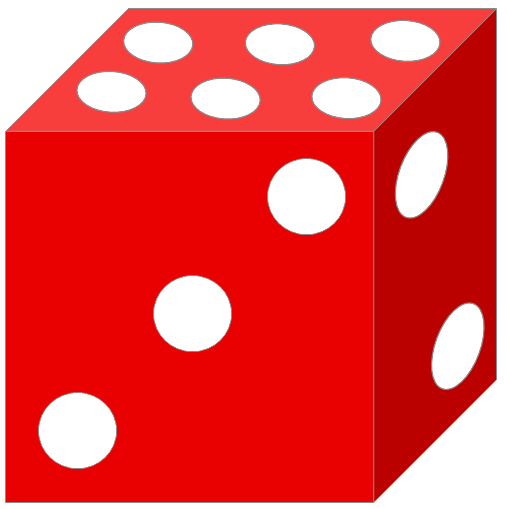S5 Probability rules

The probability of an event \(A\) is expressed as a number between zero and one: \(0\leq Pr(A)\leq1\) .
\(Pr(A)=0\) means that event \(A\) is impossible.
\(Pr(A)=1\) means that event \(A\) is certain.
When considering a set of all possible outcomes, an event is a particular outcome of interest.
For example:
When tossing a coin the particular event of interest might be “obtaining a head”.
In considering the weather for Saturday the event of interest might be “it doesnt rain” .
In planning a two child family the particular event of interest might be “a boy and a girl”.
The probability of an event \(E\) can be found with the formula: \[ Pr(E)=\frac{number\ of\ ways\ E\ can\ occur}{total\ number\ of\ possible\ outcomes} \] (assuming all outcomes are equally likely).
Examples:
1. If two coins are tossed find the probability of obtaining two heads.
Let \(E\) be the event “two heads”. If H = Heads and T = Tails, the total possible outcomes are HH HT TH TT
\[ Pr(E)=\frac{number\ of\ ways\ E\ can\ occur}{total\ number\ of\ possible\ outcomes}=\frac{1}{4} \]
2. If a die is thrown, find the probability of obtaining an odd number.
Let \(E\) be the event “an odd number”. The possible outcomes are: \(1\quad3\quad5\) whereas the total number of outcomes is six.
\[ Pr(E)=\frac{number\ of\ ways\ E\ can\ occur}{total\ number\ of\ possible\ outcomes}=\frac{3}{6}=\frac{1}{2} \]
The Multiplication Principle
Two events \(A\) and \(B\) are independent if the fact that \(A\) occurs does not affect the probability of \(B\) occurring.
If \(A\) and \(B\) are independent events then \[ Pr(A\,and\,B)=Pr(A\cap B)=Pr(A)\times(B). \]
Because successive tosses of a coin are independent events, an alternate way of calculating the probability in example one (above) would be to use the multiplication principle.
The probability of a head on the first toss (\(H_{1}\)) and a head on the second toss (\(H_{2}\))
\[\begin{align*} Pr(H_{1}\cap H_{2}) & =\frac{1}{2}\text{$\times$ }\frac{1}{2}\\ & =\frac{1}{4}. \end{align*}\]
The Addition Principle
\[ Pr(A\,or\,B)=Pr(A\cup B)=Pr(A)+Pr(B)-Pr(A\cap B). \]
Or, if \(A\) and \(B\) are mutually exclusive 1 For mutually exclusive events, \[\begin{align*} \Pr\left(A\cap B\right) & =0. \end{align*}\] (cannot happen together) then
\[ Pr(A\,or\,B)=Pr(A\cup B)=Pr(A)+Pr(B) \]
If we are tossing a single die twice and want to calculate the probability that a \(6\) occurs, then the \(6\) could occur on the first toss (\(S_{1}\)) or on the second toss (\(S_{2}\))2 The events are not mutually exclusive \[\begin{align*} Pr(S_{1}\,or\,S_{2})=Pr(S_{1}\cup S_{2}) & =Pr(S_{1})+Pr(S_{2})-Pr(S_{1}\cap S_{2})\\ & =\frac{1}{6}+\frac{1}{6}-\frac{1}{36}\\ & =\frac{11}{36}. \end{align*}\]
Complementary Events
If \(E\) is an event, then “not \(E\)” or \(\overline{E}\) or \(E'\) or \(E^{c}\) is called the complement of \(E\). Examples of complementary events: “winning the grand final” and “not winning the grand final” or “passing a test” and “failing a test” or “being left handed” and “being right handed”.
In the previous example where a die was tossed twice, the probability of not getting a 6 on either the first or second toss \[\begin{align*} & =1-Pr(S_{1}\cup S_{2})\\ & =1-\frac{11}{36}\\ & =\frac{25}{36}. \end{align*}\]
Exercises
1. If 1000 tickets are sold in a raffle and one winning ticket is chosen at random, what is my probability of winning the raffle if I buy 5 tickets?
\(\dfrac{1}{200}\)
2. If I roll a die, what is the probability that the number uppermost is greater than 4?
\(\dfrac{1}{3}\)
3. A bag contains 6 white marbles and 4 black marbles. A marble is chosen, the colour recorded and it is then returned to the bag. This is repeated three times. What is the probability that all three marbles are white?
0.216
4. The probability that person A is alive in \(30\) years time is \(0.7\). The probability that person B is alive in \(30\) years time is \(0.4\) . Find the probability that: (a) both are alive in \(30\) years. (b) neither are alive in \(30\) years (c) only one is alive in \(30\) years time (d) at least one is alive in \(30\) years time.
\((a)\,0.28\quad(b)\,0.18\quad(c)\,0.54\quad(d)\,0.82\)
Download this page: S5 Probability Rules (PDF 132KB)
What's next... S6 Sample spaces
